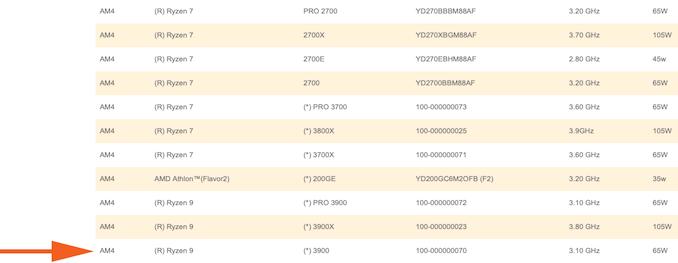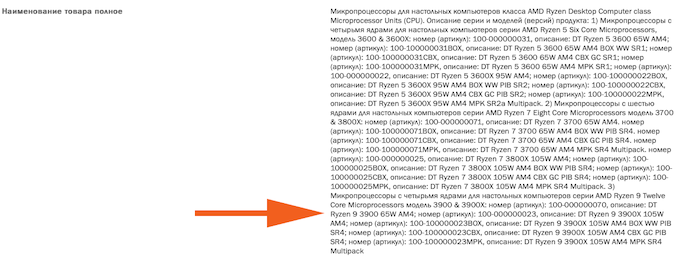AMD Ryzen 9 3900: A 12-Core 65W CPU Listed
by Anton Shilov on September 26, 2019 8:30 AM EST
A motherboard maker has added support for AMD’s yet-to-be-announced Ryzen 9 3900 CPU. The product will be one of the industry’s first 12-core CPU featuring a mainstream TDP of 65 W. In addition, the same manufacturer revealed that there is a Pro version of the said CPU incoming.
Biostar’s X470NH motherboard recently gained support for AMD’s yet-to-be-announced Ryzen 9 3900 CPU with a 65 W TDP, which may indicate that the launch of the unit is imminent. This is not the first time an unannounced CPU has been listed in a CPU validation list. As a second source, the processor was listed in Eurasian Economic Union’s index of crypto-capable devices as a ‘twelve-core microprocessor’.
| AMD Ryzen 3000 9 Series CPUs | |||||||||||
| AnandTech | Cores Threads |
Base Freq |
Boost Freq |
L2 Cache |
L3 Cache |
PCIe 4.0 |
TDP | Launch Date | Price (SEP) |
||
| Ryzen 9 | 3950X | 16C | 32T | 3.5 | 4.7 | 8 MB | 64 MB | 16+4+4 | 105W | Nov. 2019 | $749 |
| Ryzen 9 | 3900X | 12C | 24T | 3.8 | 4.6 | 6 MB | 64 MB | 16+4+4 | 105W | July 2019 | $499 |
| Ryzen 9 | 3900 | 12C | 24T | 3.1 | 4.2? | 6 MB | 64 MB | 16+4+4 | 65W | ? | ? |
Based on the information provided by the sources, AMD’s Ryzen 9 3900 is a 12-core CPU with SMT that operates at 3.1 GHz default frequency (and presumably featuring a 4.2 GHz maximum turbo frequency from a 3DMark listing) and a 65 W TDP. The relatively low thermal envelope makes the Ryzen 9 3900 compatible with mainstream motherboards and cooling systems and enables PC makers to build relatively small computers featuring a 12-core processor. Meanwhile, the Ryzen 9 Pro 3900 adds various security technologies, enterprise management, and reliability enhancements for business and corporate computers.
It is unclear when exactly AMD plans to introduce its 12-core Ryzen 9 3900 and Ryzen 9 Pro 3900 processors and how much will they cost, yet it is reasonable to think that both products will be available in the near future.
Related Reading:
- AMD Ryzen 5 3500 & 3500X Support Spotted
- The AMD 3rd Gen Ryzen Deep Dive Review: 3700X and 3900X Raising The Bar
- AMD: Next Gen Threadripper and Ryzen 9 3950X, Coming November
Sources: Biostar (via momomo_us/Twitter), EAUnion.org (via Planet3DNow)












48 Comments
View All Comments
Mookid - Thursday, September 26, 2019 - link
I’ve been satisfied with Intel cpus for ever, but this might be a lot better upgrade than i9 9900(s).jgraham11 - Thursday, September 26, 2019 - link
Yeah me too up until recently! First was the patch for Intel's Meltdown bug (Huge slow down), then patches for spectre which Intel CPUs are vulnerable to all of them. Then patches for the Zombieload bug (an Intel exclusive). According to some benchmarks, my Intel sandy bridge is running at half the speed it was. I bought my first AMD Ryzen system last year, no CPU bugs and no regrets!I read on Anandtech a little while ago that most big server companies are shutting off Hypertheading because that's where the bugs are from, so you only get half the performance you paid for!
jgraham11 - Thursday, September 26, 2019 - link
On yeah forgot Foreshadow, Intel processors are also vulnerable to that one. The best part of all these bugs is that Intel knew about these bugs when they released their 9th Gen Skylake refresh refresh processors, their 8th Gen Skylake refresh, and the original Skylake processors were continued to be sold with a known massive security vulnerabilities in them. Great company eh!Reflex - Thursday, September 26, 2019 - link
So you are hosting a large virtualized SQL server? Can't see any other way you are seeing perf hits like that. For regular desktop use and gaming, the perf hit of the patches ranges from 0-5%, and the 'half speed' you claim would require some very specialized usage profiles that are not in the realm of typical users.Plenty of reasons to go AMD these days, don't have to make things up.
rahvin - Thursday, September 26, 2019 - link
To get that 0-5% hit you have to disable most of the patches. Even with the later meltdown patches that reduced the impact you still see upwards of a 10-15% hit with all the patches enabled, and if you got the extra step and disable hyperthreading because of it's intrinsic vulnerabilities on Intel you can end up with a near 25% hit depending on model.For a normal desktop usage scenario it's assumed you don't need most of the spectre patches because you aren't running VM's or server software with untrusted users so the patches don't get enabled leaving you vulnerable. The sneaky thing is most desktop users on windows aren't aware the patches aren't being enabled, it's being decided for them by windows. For the most part desktop users don't need most of these patches to be relatively safe, but if you want to be for sure safe or you are running potentially dangerous software you need to enable them and the real performance impact for the older processors (7th gen and older) can be pretty significant, especially with all the patches.
Though a 50% hit on Sandy or Icy Bridge is IMO out of the realm of possibility with the current patches. Early on the big hit on these processors was the meltdown patch, but once windows moved the patch to the method that the Linux Kernel used (retpoline) this impact was significantly reduced. I think the biggest you can get on those two processors with all the current patches is around 20-25% and IIRC that's with disabling hyperthreading as a precaution against future spectre variants.
The scary thing with the spectre variants is they don't know how far this is going to go and some of the exploits are remote capable. As this type of attack was only proved capable a little while ago it's concievable that as more and more variants are discovered that "drive-by" exploits could end up in javascript on the web, and that's the scary part.
msroadkill612 - Friday, September 27, 2019 - link
Some of us have lives outside of figuring what is slowing our computers. It happens at the best of times w/ bloat etc. Juggling which patches are pertinent etc. on top of that, complicates matters exponentially.I think the naysayer poster is viewing it from the perspective of a tightly run IT dept, rather than plain folks and smaller entities.
We sure know they hit some workloads...discerning which affect us is time we would rather not waste, ta very much.
Reflex - Friday, September 27, 2019 - link
Again, this is not true at all. Multiple sites have profiled the perf impact of these fixes. For typical user and gamer workloads, the impact even with all mitigations applied is negligible. That picture changes in certain other specialized workloads, such as virtualization and databases (especially SQL) the hit can be in some specific situations as high as 30%. Those situations are rare and not at all within a normal desktop user's workflow.While you are correct that Spectre is the gift that keeps on giving, that specific series of exploits is nearly identical across Intel and AMD, and has no easy mitigation for anyone (it also impacts non CPU hardware, btw).
If you are going to keep claiming this, I request that you actually back it up with benchmarks from reputable reviewers.
Source: Both websites and the fact that I was personally profiling this impact *before* the CVE was publicly released due to my job. But again, you don't have to take my word for it, here is an initial overview from this very site from the very first set of patches/mitigations which had not yet been performance optimized (it's improved drastically since): https://www.anandtech.com/show/12566/analyzing-mel...
Yes, drops, but very would be user detectable, and the worst one (storage performance) was long ago fixed.
Reflex - Friday, September 27, 2019 - link
And just because I happened to pull up a search on the topic, here is a more recent test, focusing on server workloads: https://www.extremetech.com/computing/291649-intel...As can be seen there, worst case with HT disabled and all mitigations applied, sees a 25% hit in very specific workloads. On average a 15-16% hit is taken across the tasks. This is a big deal, but again these are servers, consumer workloads aren't seeing hits like this or even close.
Reflex - Friday, September 27, 2019 - link
And just because I happened to pull up a search on the topic, here is a more recent test, focusing on server workloads: https://www.extremetech.com/computing/291649-intel...As can be seen there, worst case with HT disabled and all mitigations applied, sees a 25% hit in very specific workloads. On average a 15-16% hit is taken across the tasks. This is a big deal, but again these are servers, consumer workloads aren't seeing hits like this or even close.
Alexvrb - Saturday, September 28, 2019 - link
The benches are performed on systems that may or may not have every available mitigation actually applied. I highly doubt any of these testers verified their test system wasn't actually vulnerable to the latest side channel attacks. They just install the latest OS updates and say "yep, it's patchz0redz". Intel just sends the microcode update out to vendors and let them decide what to do with it... for a consumer platform it's not "necessary" to enable some of them by default. Heck, they may not even do THAT much any more for Sandy.Recent Windows benches are also performed with both Retpoline AND Import Optimization now enabled by default, which helps tremendously regardless of what mitigations have been applied.